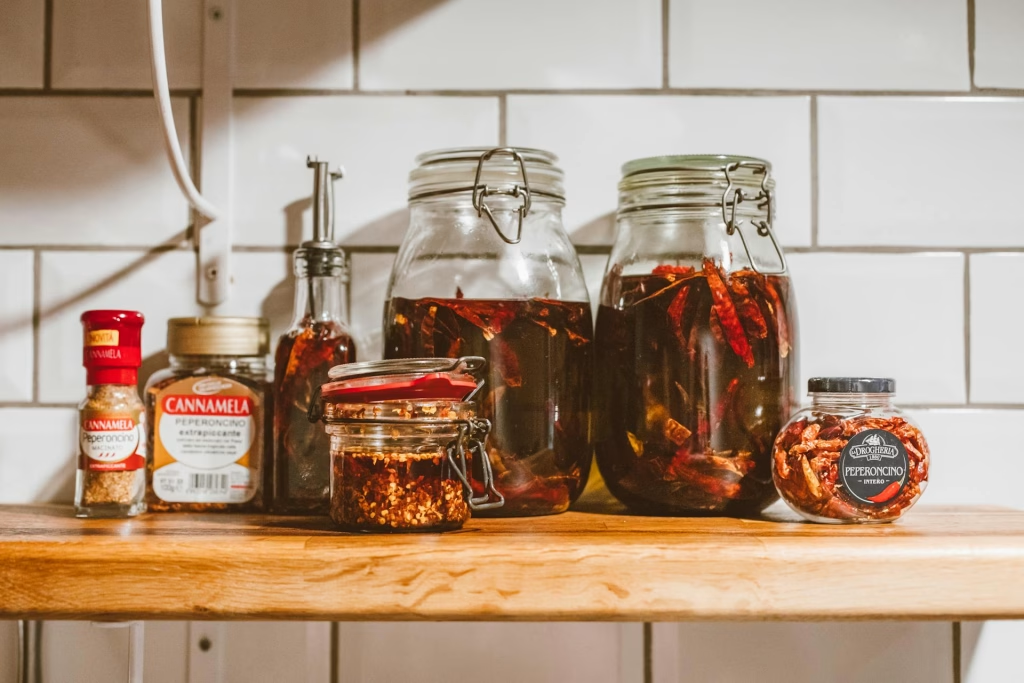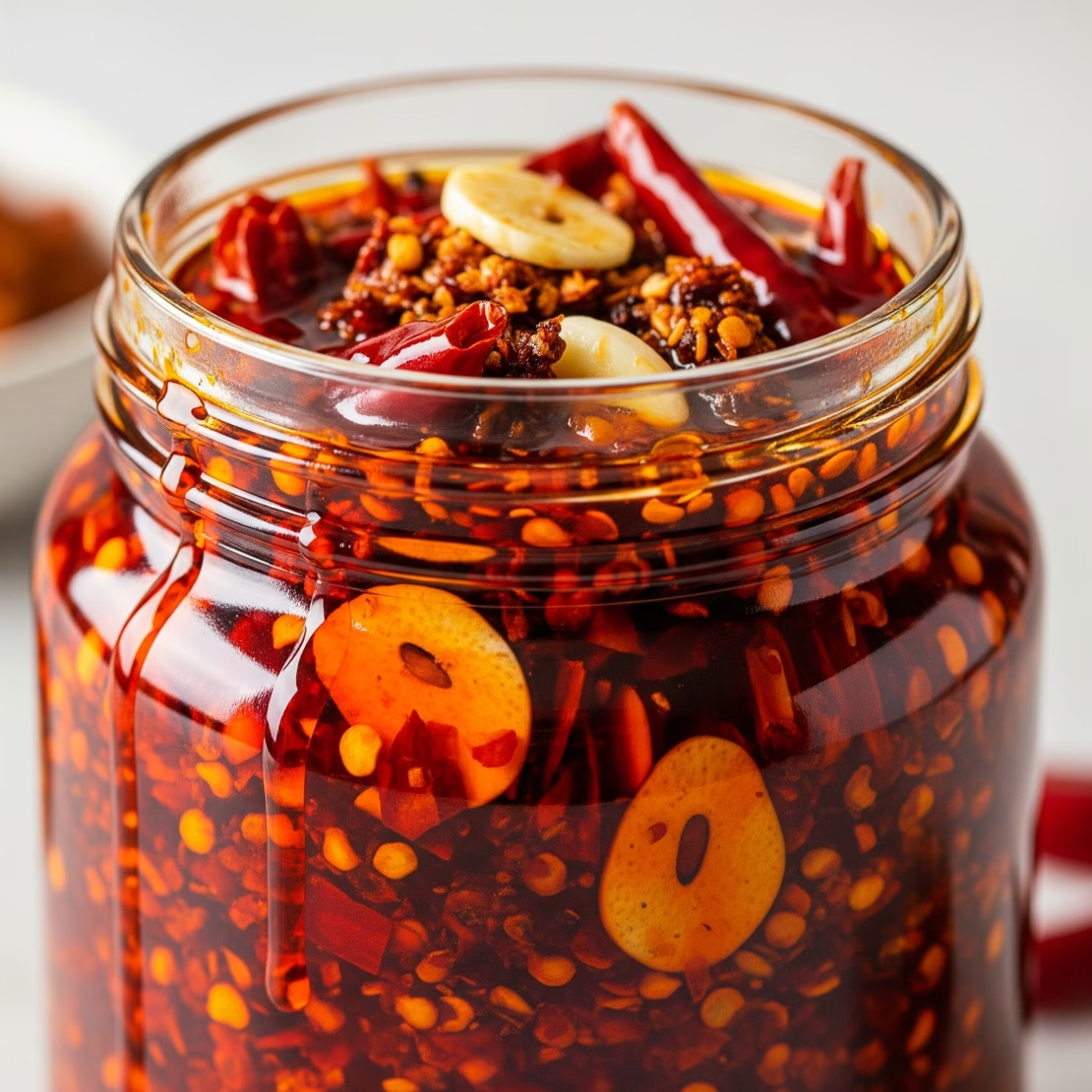Making chili oil at home is a simple and customizable process that allows you to tailor the flavor and spiciness to your liking.
Chili oil, with its fiery hue and bold flavor, is a beloved condiment that adds a kick to countless dishes around the globe. Originating in the heart of Chinese cuisine, this spicy elixir has transcended cultural boundaries, finding its place in kitchens worldwide.
In this comprehensive guide, we’ll explore the art of crafting chili oil, from selecting the perfect peppers to infusing aromatic oils with tantalizing spices. Whether you’re a seasoned chef or a novice in the kitchen, join us on a journey to master the art of chili oil and elevate your culinary creations to new heights.
Here’s a basic recipe for homemade chili oil with the option to strain or leave in the solids:
Table of Contents
Ingredients
- 1 cup of vegetable oil (such as peanut or canola oil)
- 1/4 cup of crushed red pepper flakes
- 2 tablespoons of whole Sichuan peppercorns (optional, for added flavor)
- 3-4 cloves of garlic, thinly sliced
- 2 tablespoons of sesame seeds (optional)
- 1 teaspoon of soy sauce (optional, for flavor)
- 1 teaspoon of sugar (optional, for a hint of sweetness)
Instructions
Prepare the Ingredients
- Thinly slice the garlic cloves and set them aside.
- If using whole Sichuan peppercorns, lightly toast them in a dry pan over low heat until fragrant. Be careful not to burn them.
Infuse the Oil
- Heat the vegetable oil in a saucepan over medium heat until it reaches around 325°F (163°C).
- Add the crushed red pepper flakes, sliced garlic, and toasted Sichuan peppercorns to the oil.
- Let the ingredients simmer over low heat for about 5-10 minutes. This infuses the oil with the flavors of the spices.
Add Additional Flavors (Optional):
- If desired, stir in sesame seeds, soy sauce, and sugar for added depth of flavor. Adjust the quantities based on your taste preferences.
Cool the Chili Oil
- Once the oil has absorbed the flavors, remove it from heat and let it cool to room temperature. This will take approximately 20-30 minutes.
Strain or Leave in Solids
- Decide whether to strain the chili oil or leave in the solids for added texture and flavor.
- If straining, use a fine-mesh sieve or cheesecloth to remove the solids.
Store:
- Transfer the strained or unstrained oil to a clean, airtight glass container or bottle.
Your homemade chili oil is ready to use! Drizzle it over dishes like noodles, stir-fries, dumplings, or any other dishes that could benefit from a spicy kick.
Note: The spiciness of your chili oil depends on the type of chili flakes used and the infusion time. Adjust quantities to suit your taste. Store the chili oil in a cool, dark place, and it should last for several weeks. If you notice any off smells or changes in color, it’s a sign that the oil may have gone bad.

Tips for Making Chili Oil
- Choosing Chili Peppers: Select chili peppers according to your heat preference. Common choices include Thai bird’s eye chili for extra heat or milder options like red jalapeños or Fresno peppers.
- Adjusting Heat Levels: To control the spiciness, remove the seeds and membranes from the chili peppers before infusing them in oil. The seeds and membranes contain most of the heat.
- Infusion Time: Let the chili peppers infuse in the oil for at least a few hours, preferably overnight, to develop maximum flavor. However, be cautious not to leave them for too long as it may lead to bitterness.
- Oil Selection: Use a neutral-flavored oil with a high smoke point, such as vegetable oil or peanut oil, to avoid overpowering the chili flavor.
- Flavor Enhancers: Add aromatics like garlic, ginger, Sichuan peppercorns, and star anise to infuse additional flavors into the oil. Toasting these ingredients lightly before adding them can deepen their flavors.
- Storage: Store chili oil in a clean, airtight jar or bottle in a cool, dark place. Properly stored chili oil can last for several weeks to a few months.
Variations of Chili Oil
- Sichuan-style Chili Oil: Includes Sichuan peppercorns, star anise, and sometimes ginger and cinnamon for a distinctive numbing and aromatic flavor.
- Garlic Chili Oil: Infused with garlic cloves along with chili peppers for added depth of flavor.
- Black Bean Chili Oil: Incorporates fermented black beans for a savory, umami-rich twist.
- Toasted Sesame Chili Oil: Adds toasted sesame seeds or sesame oil for a nutty flavor and aroma.
- Herb-infused Chili Oil: Experiment with adding herbs like rosemary, thyme, or basil for a unique herbal note.
History of Chili Oil
Chili oil, also known as hot chili oil or red oil, has its roots in Chinese cuisine, particularly in Sichuan and Hunan provinces. It’s a staple condiment in many Asian cuisines, including Chinese, Korean, and Thai.
Traditionally, it was made by infusing dried chili peppers in hot oil along with spices and aromatics to create a fragrant and fiery oil used to add heat and flavor to dishes. Over time, chili oil has gained popularity worldwide, often used as a condiment for dumplings, noodles, stir-fries, and various other dishes.
Its versatility and ability to enhance the flavor of a wide range of foods have contributed to its widespread use in both home cooking and restaurant kitchens.


